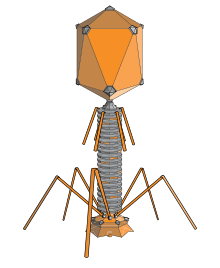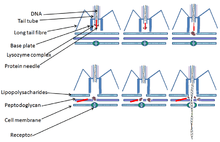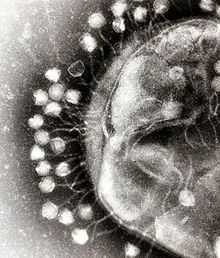Bacteriophage

A bacteriophage (informally, phage) is a virus that infects and replicates within bacteria. The term is derived from 'bacteria' and the Greek φαγεῖν phagein "to devour". Bacteriophages are composed of proteins that encapsulate a DNA or RNA genome, and may have relatively simple or elaborate structures. Their genomes may encode as few as four genes, and as many as hundreds of genes. Phage replicate within bacteria following the injection of their genome into the cytoplasm. Bacteriophage are among the most common and diverse entities in the biosphere.[1]
Phages are widely distributed in locations populated by bacterial hosts, such as soil or the intestines of animals. One of the densest natural sources for phages and other viruses is sea water, where up to 9×108 virions per milliliter have been found in microbial mats at the surface,[2] and up to 70% of marine bacteria may be infected by phages.[3] They have been used for over 90 years as an alternative to antibiotics in the former Soviet Union and Central Europe, as well as in France.[4] They are seen as a possible therapy against multi-drug-resistant strains of many bacteria.[5]
Classification
The dsDNA tailed phages, or Caudovirales, account for 95% of all the phages reported in the scientific literature, and possibly make up the majority of phages on the planet.[1] However, other phages occur abundantly in the biosphere, with different virions, genomes and lifestyles. Phages are classified by the International Committee on Taxonomy of Viruses (ICTV) according to morphology and nucleic acid.
Nineteen families are currently recognised that infect bacteria and archaea. Of these, only two families have RNA genomes and only five families are enveloped. Of the viral families with DNA genomes, only two have single-stranded genomes. Eight of the viral families with DNA genomes have circular genomes, while nine have linear genomes. Nine families infect bacteria only, nine infect archaea only, and one (Tectiviridae) infects both bacteria and archaea.
| Order | Family | Morphology | Nucleic acid | Examples |
|---|---|---|---|---|
| Caudovirales | Myoviridae | Nonenveloped, contractile tail | Linear dsDNA | T4 phage, Mu, PBSX, P1Puna-like, P2, I3, Bcep 1, Bcep 43, Bcep 78 |
| Siphoviridae | Nonenveloped, noncontractile tail (long) | Linear dsDNA | λ phage, T5 phage, phi, C2, L5, HK97, N15 | |
| Podoviridae | Nonenveloped, noncontractile tail (short) | Linear dsDNA | T7 phage, T3 phage, P22, P37 | |
| Ligamenvirales | Lipothrixviridae | Enveloped, rod-shaped | Linear dsDNA | Acidianus filamentous virus 1 |
| Rudiviridae | Nonenveloped, rod-shaped | Linear dsDNA | Sulfolobus islandicus rod-shaped virus 1 | |
| Unassigned | Ampullaviridae | Enveloped, bottle-shaped | Linear dsDNA | |
| Bicaudaviridae | Nonenveloped, lemon-shaped | Circular dsDNA | ||
| Clavaviridae | Nonenveloped, rod-shaped | Circular dsDNA | ||
| Corticoviridae | Nonenveloped, isometric | Circular dsDNA | ||
| Cystoviridae | Enveloped, spherical | Segmented dsRNA | ||
| Fuselloviridae | Nonenveloped, lemon-shaped | Circular dsDNA | ||
| Globuloviridae | Enveloped, isometric | Linear dsDNA | ||
| Guttavirus | Nonenveloped, ovoid | Circular dsDNA | ||
| Inoviridae | Nonenveloped, filamentous | Circular ssDNA | ||
| Leviviridae | Nonenveloped, isometric | Linear ssRNA | MS2, Qβ | |
| Microviridae | Nonenveloped, isometric | Circular ssDNA | ΦX174 | |
| Plasmaviridae | Enveloped, pleomorphic | Circular dsDNA | ||
| Tectiviridae | Nonenveloped, isometric | Linear dsDNA |
History

Since ancient times, reports of river waters having the ability to cure infectious diseases, such as leprosy, have been documented. In 1896, Ernest Hanbury Hankin reported that something in the waters of the Ganges and Yamuna rivers in India had marked antibacterial action against cholera and could pass through a very fine porcelain filter. In 1915, British bacteriologist Frederick Twort, superintendent of the Brown Institution of London, discovered a small agent that infected and killed bacteria. He believed the agent must be one of the following:
- a stage in the life cycle of the bacteria;
- an enzyme produced by the bacteria themselves; or
- a virus that grew on and destroyed the bacteria.
Twort's work was interrupted by the onset of World War I and shortage of funding. Independently, French-Canadian microbiologist Félix d'Hérelle, working at the Pasteur Institute in Paris, announced on 3 September 1917, that he had discovered "an invisible, antagonistic microbe of the dysentery bacillus". For d’Hérelle, there was no question as to the nature of his discovery: "In a flash I had understood: what caused my clear spots was in fact an invisible microbe ... a virus parasitic on bacteria."[6] D'Hérelle called the virus a bacteriophage or bacteria-eater (from the Greek phagein meaning to eat). He also recorded a dramatic account of a man suffering from dysentery who was restored to good health by the bacteriophages.[7] It was D'Herelle who conducted much research into bacteriophages and introduced the concept of phage therapy.[8]
In 1969, Max Delbrück, Alfred Hershey and Salvador Luria were awarded the Nobel Prize in Physiology and Medicine for their discoveries of the replication of viruses and their genetic structure.[9]
Phage therapy
Phages were discovered to be antibacterial agents and were used in Georgia and the United States during the 1920s and 1930s for treating bacterial infections. They had widespread use, including treatment of soldiers in the Red Army. However, they were abandoned for general use in the West for several reasons:
- Medical trials were carried out, but a basic lack of understanding of phages made these invalid.
- Phage therapy was seen as untrustworthy, because many of the trials were conducted on totally unrelated diseases such as allergies and viral infections.
- Antibiotics were discovered and marketed widely. They were easier to make, store and to prescribe.
- Former Soviet research continued, but publications were mainly in Russian or Georgian languages, and were unavailable internationally for many years.
- Clinical trials evaluating the antibacterial efficacy of bacteriophage preparations were conducted without proper controls and were methodologically incomplete preventing the formulation of important conclusions
Their use has continued since the end of the Cold War in Georgia and elsewhere in Central and Eastern Europe. Globalyz Biotech is an international joint venture that commercializes bacteriophage treatment and its various applications across the globe. The company has successfully used bacteriophages in administering Phage therapy to patients suffering from bacterial infections, including: Staphylococcus (including MRSA), Streptococcus, Pseudomonas, Salmonella, skin and soft tissue, gastrointestinal, respiratory, and orthopedic infections. In 1923, the Eliava Institute was opened in Tbilisi, Georgia, to research this new science and put it into practice.
The first regulated randomized, double blind clinical trial was reported in the Journal of Wound Care in June 2009, which evaluated the safety and efficacy of a bacteriophage cocktail to treat infected venous leg ulcers in human patients. The study was approved by the FDA as a Phase I clinical trial. Study results satisfactorily demonstrated safety of therapeutic application of bacteriophages, however it did not show efficacy. The authors explain that the use of certain chemicals that are part of standard wound care (e.g. lactoferrin, silver) may have interfered with bacteriophage viability. Another regulated clinical trial in Western Europe (treatment of ear infections caused by Pseudomonas aeruginosa) was reported shortly after in the journal Clinical Otolaryngology in August 2009.[14] The study concludes that bacteriophage preparations were safe and effective for treatment of chronic ear infections in humans. Additionally, there have been numerous animal and other experimental clinical trials evaluating the efficacy of bacteriophages for various diseases, such as infected burns and wounds, and cystic fibrosis associated lung infections, among others. Meanwhile, Western scientists are developing engineered viruses to overcome antibiotic resistance, and engineering the phage genes responsible for coding enzymes which degrade the biofilm matrix, phage structural proteins and also enzymes responsible for lysis of bacterial cell wall.[2][3][4]
Replication

Bacteriophages may have a lytic cycle or a lysogenic cycle, and a few viruses are capable of carrying out both. With lytic phages such as the T4 phage, bacterial cells are broken open (lysed) and destroyed after immediate replication of the virion. As soon as the cell is destroyed, the phage progeny can find new hosts to infect. Lytic phages are more suitable for phage therapy. Some lytic phages undergo a phenomenon known as lysis inhibition, where completed phage progeny will not immediately lyse out of the cell if extracellular phage concentrations are high. This mechanism is not identical to that of temperate phage going dormant and is usually temporary.
In contrast, the lysogenic cycle does not result in immediate lysing of the host cell. Those phages able to undergo lysogeny are known as temperate phages. Their viral genome will integrate with host DNA and replicate along with it fairly harmlessly, or may even become established as a plasmid. The virus remains dormant until host conditions deteriorate, perhaps due to depletion of nutrients; then, the endogenous phages (known as prophages) become active. At this point they initiate the reproductive cycle, resulting in lysis of the host cell. As the lysogenic cycle allows the host cell to continue to survive and reproduce, the virus is reproduced in all of the cell’s offspring. An example of a bacteriophage known to follow the lysogenic cycle and the lytic cycle is the phage lambda of E. coli.[10]
Sometimes prophages may provide benefits to the host bacterium while they are dormant by adding new functions to the bacterial genome in a phenomenon called lysogenic conversion. Examples are the conversion of harmless strains of Corynebacterium diphtheriae or Vibrio cholerae by bacteriophages to a highly virulent ones, which cause Diphtheria or cholera, respectively.[11][12] Strategies to combat certain bacterial infections by targeting these toxin-encoding prophages have been proposed.[13]
Attachment and penetration

To enter a host cell, bacteriophages attach to specific receptors on the surface of bacteria, including lipopolysaccharides, teichoic acids, proteins, or even flagella. This specificity means a bacteriophage can infect only certain bacteria bearing receptors to which they can bind, which in turn determines the phage's host range. Host growth conditions also influence the ability of the phage to attach and invade them.[14] As phage virions do not move independently, they must rely on random encounters with the right receptors when in solution (blood, lymphatic circulation, irrigation, soil water, etc.).
Myovirus bacteriophages use a hypodermic syringe-like motion to inject their genetic material into the cell. After making contact with the appropriate receptor, the tail fibers flex to bring the base plate closer to the surface of the cell; this is known as reversible binding. Once attached completely, irreversible binding is initiated and the tail contracts, possibly with the help of ATP present in the tail,[3] injecting genetic material through the bacterial membrane. Podoviruses lack an elongated tail sheath similar to that of a myovirus, so they instead use their small, tooth-like tail fibers to enzymatically degrade a portion of the cell membrane before inserting their genetic material.
Synthesis of proteins and nucleic acid
Within minutes, bacterial ribosomes start translating viral mRNA into protein. For RNA-based phages, RNA replicase is synthesized early in the process. Proteins modify the bacterial RNA polymerase so it preferentially transcribes viral mRNA. The host’s normal synthesis of proteins and nucleic acids is disrupted, and it is forced to manufacture viral products, instead. These products go on to become part of new virions within the cell, helper proteins that help assemble the new virions, or proteins involved in cell lysis. Walter Fiers (University of Ghent, Belgium) was the first to establish the complete nucleotide sequence of a gene (1972) and of the viral genome of bacteriophage MS2 (1976).[15]
Virion assembly
In the case of the T4 phage, the construction of new virus particles involves the assistance of helper proteins. The base plates are assembled first, with the tails being built upon them afterwards. The head capsids, constructed separately, will spontaneously assemble with the tails. The DNA is packed efficiently within the heads. The whole process takes about 15 minutes.

Release of virions
Phages may be released via cell lysis, by extrusion, or, in a few cases, by budding. Lysis, by tailed phages, is achieved by an enzyme called endolysin, which attacks and breaks down the cell wall peptidoglycan. An altogether different phage type, the filamentous phages, make the host cell continually secrete new virus particles. Released virions are described as free, and, unless defective, are capable of infecting a new bacterium. Budding is associated with certain Mycoplasma phages. In contrast to virion release, phages displaying a lysogenic cycle do not kill the host but, rather, become long-term residents as prophage.
Genome structure
Bacteriophage genomes are especially mosaic: the genome of any one phage species appears to be composed of numerous individual modules. These modules may be found in other phage species in different arrangements. Mycobacteriophages - bacteriophages with mycobacterial hosts - have provided excellent examples of this mosaicism. In these mycobacteriophages, genetic assortment may be the result of repeated instances of site-specific recombination and illegitimate recombination (the result of phage genome acquisition of bacterial host genetic sequences).[16] It should be noted, however, that evolutionary mechanisms shaping the genomes of bacterial viruses vary between different families and depend on the type of the nucleic acid, characteristics of the virion structure, as well as the mode of the viral life cycle.[17]
In the environment
Metagenomics has allowed the in-water detection of bacteriophages that was not possible previously. These investigations revealed phages are much more abundant in the water column of both freshwater and marine habitats than previously thought,[18] and they can cause significant mortality of bacterioplankton. Methods in phage community ecology have been developed to assess phage-induced mortality of bacterioplankton and its role for food web process and biogeochemical cycle to genetically fingerprint phage communities or populations and estimate viral biodiversity by metagenomics. The lysis of bacteria by phages releases organic carbon that was previously particulate (cells) into dissolved forms, which makes the carbon more available to other organisms. Phages are not only the most abundant biological entities but also probably the most diverse ones. The majority of the sequence data obtained from phage communities have no equivalents in databases. These data and other detailed analyses indicate phage-specific genes and ecological traits are much more frequent than previously thought. To reveal the meaning of this genetic and ecological versatility, studies have to be performed with communities and at spatiotemporal scales relevant for microorganisms.[1]
Bacteriophages have also been used in hydrological tracing and modelling in river systems, especially where surface water and groundwater interactions occur. The use of phages is preferred to the more conventional dye marker because they are significantly less absorbed when passing through ground waters and they are readily detected at very low concentrations.[19]
Role in food fermentation
A broad number of food products, commodity chemicals, and biotechnology products are manufactured industrially by large-scale bacterial fermentation of various organic substrates. Because enormous amounts of bacteria are being cultivated each day in large fermentation vats, the risk of bacteriophage contamination could rapidly bring fermentation to a halt. The resulting economic setback is a serious threat in these industries. The relationship between bacteriophages and their bacterial hosts is very important in the context of the food fermentation industry. Sources of phage contamination, measures to control their propagation and dissemination, and biotechnological defense strategies developed to restrain phages are of interest. The dairy fermentation industry has openly acknowledged the problem of phages and has been working with academia and starter culture companies to develop defense strategies and systems to curtail the propagation and evolution of phages for decades.[1]
Other areas of use
Since 2006, the United States Food and Drug Administration (FDA) and USDA have approved several bacteriophage products. Intralytix introduced LMP-102, also called ListShield as a food additive to target and kill Listeria monocytogenes. LMP-102 (ListShield by Intralytix) was approved for treating ready-to-eat (RTE) poultry and meat products. In that same year, the FDA approved LISTEX by Micreos (formerly EBI Food Safety) using bacteriophages on cheese to kill the L. monocytogenes bacteria, giving them generally recognized as safe (GRAS) status.[20] In July 2007, the same bacteriophage were approved for use on all food products.[21] In 2011 USDA confirmed that LISTEX is a clean label processing-aid and is included in USDA.[22] Research in the field of food safety is continuing to see if lytic phages are a viable option to control other food-borne pathogens in various food products.
Government agencies in the West have for several years been looking to Georgia and the former Soviet Union for help with exploiting phages for counteracting bioweapons and toxins, such as anthrax and botulism.[23] Developments are continuing among research groups in the US. Other uses include spray application in horticulture for protecting plants and vegetable produce from decay and the spread of bacterial disease. Other applications for bacteriophages are as biocides for environmental surfaces, e.g., in hospitals, and as preventative treatments for catheters and medical devices prior to use in clinical settings. The technology for phages to be applied to dry surfaces, e.g., uniforms, curtains, or even sutures for surgery now exists. Clinical trials reported in the Lancet[24] show success in veterinary treatment of pet dogs with otitis.
Phage display is a different use of phages involving a library of phages with a variable peptide linked to a surface protein. Each phage's genome encodes the variant of the protein displayed on its surface (hence the name), providing a link between the peptide variant and its encoding gene. Variant phages from the library can be selected through their binding affinity to an immobilized molecule (e.g., botulism toxin) to neutralize it. The bound, selected phages can be multiplied by reinfecting a susceptible bacterial strain, thus allowing them to retrieve the peptides encoded in them for further study.[citation needed]
The SEPTIC bacterium sensing and identification method uses the ion emission and its dynamics during phage infection and offers high specificity and speed for detection.[citation needed]
Phage-ligand technology makes use of proteins, which are identified from bacteriophages, characterized and recombinantly expressed for various applications such as binding of bacteria and bacterial components (e.g. endotoxin) and lysis of bacteria.[25]
Model bacteriophages
The following bacteriophages are extensively studied:
- Lambda phage (λ phage) – lysogen (λ phage is the most studied and important phage in genetics research.[26])
- T2 phage
- T4 phage (169 kbp genome,[27] 200 nm long[citation needed])
- T7 phage
- T12 phage
- R17 phage
- M13 phage
- MS2 phage (23–25 nm in size[citation needed])
- G4 phage
- P1 phage
- Enterobacteria phage P2
- P4 phage
- Phi X 174 phage
- N4 phage
- Pseudomonas phage Φ6
- Φ29 phage
- 186 phage
Cultural references
- In 1925 in the Pulitzer Prize-winning novel Arrowsmith, Sinclair Lewis fictionalized the discovery and application of bacteriophages as a therapeutic agent.
See also
- Bacterivore
- DNA viruses
- Phage ecology
- Phage monographs (a comprehensive listing of phage and phage-associated monographs, 1921 – present)
- Polyphage
- RNA viruses
- Transduction
- Viriome
References
- ↑ 1.0 1.1 1.2 1.3 1.4 Mc Grath S and van Sinderen D (editors). (2007). Bacteriophage: Genetics and Molecular Biology (1st ed.). Caister Academic Press. ISBN 978-1-904455-14-1. .
- ↑ 2.0 2.1 Wommack, K. E.; Colwell, R. R. (2000). "Virioplankton: Viruses in Aquatic Ecosystems". Microbiology and Molecular Biology Reviews 64 (1): 69–114. doi:10.1128/MMBR.64.1.69-114.2000. PMC 98987. PMID 10704475.
- ↑ 3.0 3.1 3.2 Prescott, L. (1993). Microbiology, Wm. C. Brown Publishers, ISBN 0-697-01372-3
- ↑ 4.0 4.1 BBC Horizon (1997): The Virus that Cures – Documentary about the history of phage medicine in Russia and the West
- ↑ Keen, E. C. (2012). "Phage Therapy: Concept to Cure". Frontiers in Microbiology 3. doi:10.3389/fmicb.2012.00238.
- ↑ Félix d'Hérelles (1917). "Sur un microbe invisible antagoniste des bacilles dysentériques" (PDF). Comptes rendus Acad Sci Paris. 165: 373–5. Archived from the original on 4 December 2010. Retrieved 5 September 2010.
- ↑ Félix d'Hérelle (1949). "The bacteriophage" (PDF). Science News 14: 44–59. Retrieved 5 September 2010.
- ↑ Keen EC (2012). "Felix d’Herelle and Our Microbial Future". Future Microbiology 7 (12): 1337–1339. doi:10.2217/fmb.12.115. PMID 23231482.
- ↑ "The Nobel Prize in Physiology or Medicine 1969". Nobel Foundation. Retrieved 2007-07-28.
- ↑ Mason, Kenneth A., Jonathan B. Losos, Susan R. Singer, Peter H Raven, and George B. Johnson. (2011). Biology, p. 533. McGraw-Hill, New York. ISBN 978-0-07-893649-4.
- ↑ Mokrousov I (January 2009). "Corynebacterium diphtheriae: genome diversity, population structure and genotyping perspectives". Infection, Genetics and Evolution 9 (1): 1–15. doi:10.1016/j.meegid.2008.09.011. PMID 19007916.
- ↑ Charles RC, Ryan ET (October 2011). "Cholera in the 21st century". Current Opinion in Infectious Diseases 24 (5): 472–7. doi:10.1097/QCO.0b013e32834a88af. PMID 21799407.
- ↑ Keen, E. C. (2012). "Paradigms of pathogenesis: Targeting the mobile genetic elements of disease". Frontiers in Cellular and Infection Microbiology 2. doi:10.3389/fcimb.2012.00161.
- ↑ Gabashvili, I.; Khan, S.; Hayes, S.; Serwer, P. (1997). "Polymorphism of bacteriophage T7". Journal of Molecular Biology 273 (3): 658. doi:10.1006/jmbi.1997.1353. PMID 9356254.
- ↑ Fiers, W.; Contreras, R.; Duerinck, F.; Haegeman, G.; Iserentant, D.; Merregaert, J.; Min Jou, W.; Molemans, F.; Raeymaekers, A.; Van Den Berghe, A.; Volckaert, G.; Ysebaert, M. (1976). "Complete nucleotide sequence of bacteriophage MS2 RNA: primary and secondary structure of the replicase gene". Nature 260 (5551): 500–507. Bibcode:1976Natur.260..500F. doi:10.1038/260500a0. PMID 1264203.
- ↑ Morris P, Marinelli LJ, Jacobs-Sera D, Hendrix RW, Hatfull GF (March 2008). "Genomic characterization of mycobacteriophage Giles: evidence for phage acquisition of host DNA by illegitimate recombination". Journal of Bacteriology 190 (6): 2172–82. doi:10.1128/JB.01657-07. PMC 2258872. PMID 18178732.
- ↑ Krupovic M, Prangishvili D, Hendrix RW, Bamford DH (December 2011). "Genomics of bacterial and archaeal viruses: dynamics within the prokaryotic virosphere". Microbiology and Molecular Biology Reviews : MMBR 75 (4): 610–35. doi:10.1128/MMBR.00011-11. PMC 3232739. PMID 22126996.
- ↑ Breitbart, M, P Salamon, B Andresen, J Mahaffy, A Segall, D Mead, F Azam, F Rohwer (2002) Genomic analysis of uncultured marine viral communities. Proceedings of the National Academy USA. 99:14250-14255.
- ↑ Martin, C. (1988). "The Application of Bacteriophage Tracer Techniques in South West Water". Water and Environment Journal 2: 638. doi:10.1111/j.1747-6593.1988.tb01352.x.
- ↑ U.S. FDA/CFSAN: Agency Response Letter, GRAS Notice No. 000198
- ↑ (U.S. FDA/CFSAN: Agency Response Letter, GRAS Notice No. 000218)
- ↑ FSIS Directive 7120
- ↑ The New York Times: Studying anthrax in a Soviet-era lab - with Western funding
- ↑ Wright, A.; Hawkins, C.; Anggård, E.; Harper, D. (2009). "A controlled clinical trial of a therapeutic bacteriophage preparation in chronic otitis due to antibiotic-resistant Pseudomonas aeruginosa; a preliminary report of efficacy". Clinical Otolaryngology 34 (4): 349–357. doi:10.1111/j.1749-4486.2009.01973.x. PMID 19673983.
- ↑ Technological background Phage-ligand technology
- ↑ Agreement: Use of the Esther M. Zimmer Lederberg Memorial Web Site
- ↑ Miller, ES; Kutter, E, Mosig, G, Arisaka, F, Kunisawa, T, Rüger, W (March 2003). "Bacteriophage T4 genome.". Microbiology and molecular biology reviews : MMBR 67 (1): 86–156, table of contents. doi:10.1128/MMBR.67.1.86-156.2003. PMC 150520. PMID 12626685.
External links
- Animation of bacteriophage targeting E. coli bacteria
- Häusler, T. (2006) "Viruses vs. Superbugs", Macmillan
- Phage.org general information on bacteriophages
- bacteriophages illustrations and genomics
- Bacteriophages get a foothold on their prey
- NPR Science Friday podcast, "Using 'Phage' Viruses to Help Fight Infection", April 2008
- Animation by Hybrid Animation Medical for a T4 Bacteriophage targeting E. coli bacteria.
- Bacteriophages: What are they. Presentation by Professor Graham Hatfull, University of Pittsburgh on YouTube
| |||||||||||||||||||||||||||||||

